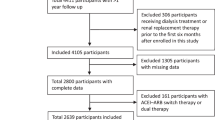Abstract
Background
Proteinuria is one of the risk factors for the progression of renal diseases including Alport syndrome (AS), a hereditary glomerular renal disease. This study aimed to evaluate the efficacy of angiotensin converting enzyme inhibitors (ACEIs) and/or tripterygium, a Chinese herbal medicine widely used in Chinese patients with hematuria and proteinuria, on proteinuria in patients with AS.
Methods
Twenty-nine children were enrolled into this retrospective study. Patients were divided into 3 therapy groups: ACEI group, tripterygium group, and ACEI plus tripterygium group.
Results
In the 29 children, 23 were male and 6 female. In the ACEI group and the tripterygium group, the effective rate was 87.5% and 25.0%, respectively and in the ACEI plus tripterygium group was 42.9%.
Conclusions
ACEI is effective in controlling proteinuria of AS patients. Tripterygium should be carefully administered in controlling proteinuria of AS patients.
Similar content being viewed by others
References
Kashtan CE. Alport syndrome and thin glomerular basement membrane disease. J Am Soc Nephrol 1998;9:1736–1750.
Burton C, Harris KP. The role of proteinuria in the progression of chronic renal failure. Am J Kidney Dis 1996;27:765–775.
Proesmans W, Knockaert H, Trouet D. Enalapril in paediatric patients with Alport syndrome: 2 years’ experience. Eur J Pediatr 2000;159:430–433.
Cohen EP, Lemann J Jr. In hereditary nephritis angiotensin-converting enzyme inhibition decreases proteinuria and may slow the rate of progression. Am J Kidney Dis 1996;27:199–203.
Proesmans W, Van Dyck M. Enalapril in children with Alport syndrome. Pediatr Nephrol 2004;19:271–275.
Gross O, Beirowski B, Koepke ML, Kuck J, Reiner M, Addicks K, et al. Preemptive ramipril therapy delays renal failure and reduces renal fibrosis in COL4A3-knockout mice with Alport syndrome. Kidney Int 2003;63:438–446.
Kaito H, Nozu K, Iijima K, Nakanishi K, Yoshiya K, Kanda K, et al. The effect of aldosterone blockade in patients with Alport syndrome. Pediatr Nephrol 2006;21:1824–1829.
Charbit M, Gubler MC, Dechaux M, Gagnadoux MF, Grünfeld JP, Niaudet P. Cyclosporin therapy in patients with Alport syndrome. Pediatr Nephrol 2007;22:57–63.
Sigmundsson TS, Palsson R, Hardarson S, Edvardsson V. Resolution of proteinuria in a patient with X-linked Alport syndrome treated with cyclosporine. Scand J Urol Nephrol 2006;40:522–525.
Proesmans W, Wambeke IV, Dyck MV. Long-term therapy with enalapril in patients with nephrotic-range proteinuria. Pediatr Nephrol 1996;10:587–589.
Jais JP, Knebelmann B, Giatras I, De Marchi M, Rizzoni G, Renieri A, et al. X-linked Alport syndrome: natural history in 195 families and genotype-phenotype correlations in males. J Am Soc Nephrol 2000;11:649–657.
Callís L, Vila A, Carrera M, Nieto J. Long-term effects of cyclosporine A in Alport’s syndrome. Kidney Int 1999;55: 1051–1056.
Chen D, Jefferson B, Harvey SJ, Zheng K, Gartley CJ, Jacobs RM, et al. Cyclosporine a slows the progressive renal disease of alport syndrome (X-linked hereditary nephritis): results from a canine model. J Am Soc Nephrol 2003;14:690–698.
Lama G, Luongo I, Piscitelli A, Salsano ME. Enalapril: antiproteinuric effect in children with nephrotic syndrome. Clin Nephrol 2000;53:432–436.
Adler L, Mathew R, Futterweit S, Frank R, Gauthier BG, Kashtan CE, et al. Angiotensin converting enzyme inhibitor therapy in children with Alport syndrome: effect on urinary albumin, TGF-beta, and nitrite excretion. BMC Nephrol 2002;3:2.
Jiang X. Clinical observations on the use of the Chinese herb Tripterygium wilfordii Hook for the treatment of nephrotic syndrome. Pediatr Nephrol 1994;8:343–344.
Zheng CX, Chen ZH, Zeng CH, Qin WS, Li LS, Liu ZH. Triptolide protects podocytes from puromycin aminonucleoside induced injury in vivo and in vitro. Kidney Int 2008;74:596–612.
Sharma M, Li JZ, Sharma R, Artero M, Ge X, McCarthy ET, et al. Inhibitory effect of Tripterygium wilfordii multiglycoside on increased glomerular albumin permeability in vitro. Nephrol Dial Transplant 1997;12:2064–2068.
Wan YG, Sun W, Wang Y, Zhang J, Li M, Ruan JG, et al. Effects of multi-glycoside of Tripterygium wilfordii Hook. f. on proteinuria and expression of slit diaphragm-associated molecules in rats with anti-thy1.1 glomerulonephritis. Zhong Guo Zhong Xi Yi Jie He Za Zhi 2006;26:1094–1102. [in Chinese]
Author information
Authors and Affiliations
Corresponding author
Rights and permissions
About this article
Cite this article
Li, JG., Ding, J., Wang, F. et al. Drugs controlling proteinuria of patients with Alport syndrome. World J Pediatr 5, 308–311 (2009). https://doi.org/10.1007/s12519-009-0059-5
Received:
Accepted:
Published:
Issue Date:
DOI: https://doi.org/10.1007/s12519-009-0059-5




